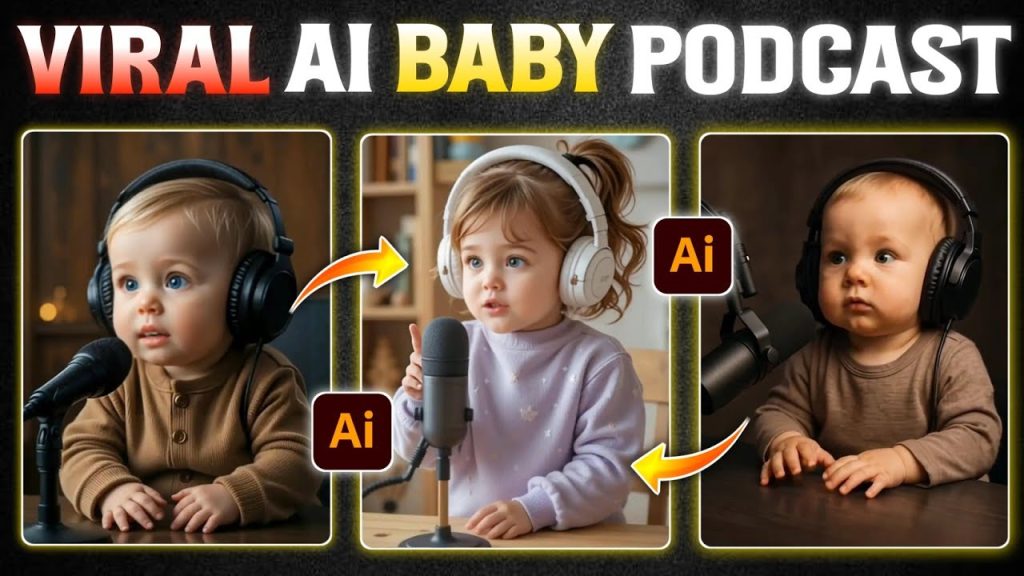Kids today are growing up in a world filled with digital content—YouTube, podcasts, and interactive apps dominate their entertainment. If you’ve ever thought about creating a kids’ podcast or video but felt intimidated by the technical side, AI is here to simplify everything!
With artificial intelligence, you can now produce high-quality, engaging, and safe content for children without needing a professional studio or expensive equipment. In this guide, we’ll explore how AI can help you craft amazing kids’ podcasts and videos—from scripting to publishing.
Why Use AI for Kids’ Content?
Creating content for children requires a mix of creativity, education, and entertainment. AI makes this easier by:
✔ Automating repetitive tasks (scriptwriting, voiceovers, editing)
✔ Reducing production costs (no need for actors or expensive software)
✔ Enhancing engagement (interactive elements, animations, and fun voices)
✔ Ensuring child-friendly content (AI moderation filters inappropriate language)
Whether you’re a parent, teacher, or content creator, AI tools can help you produce fun and educational media effortlessly.
Step 1: Brainstorming Kid-Friendly Topics
Before diving into production, decide what kind of content you want to create. Some popular formats include:
- Storytime Adventures (fairytales, superhero stories, mysteries)
- Educational Shows (science facts, history lessons, language learning)
- Interactive Fun (quiz games, joke segments, sing-alongs)
- DIY & Crafts (easy art projects, cooking for kids)
Pro Tip: Ask kids what they enjoy! Their input can help shape engaging content.

Step 2: AI-Powered Scriptwriting in Minutes
Writing a script from scratch can be daunting, but AI tools like ChatGPT, Claude, or Jasper can generate kid-friendly scripts in seconds.
How to Get the Best AI-Generated Script:
- Use a Clear Prompt – Example:
“Write a 7-minute podcast script for kids aged 6-10 about space exploration. Include fun facts, a short quiz, and a silly alien character.” - Adjust Tone & Simplicity – Ensure the language is easy to understand.
- Add Interactive Cues – Pauses for reactions, sound effects, or audience participation.
Step 3: Bringing Stories to Life with AI Voices
Hiring voice actors can be expensive, but AI-generated voices offer realistic, expressive, and child-friendly narration.
Best AI Voice Generators for Kids’ Content:
- Murf.ai (cartoon-like, energetic voices)
- Lovo.ai (features unique character voices)
- Play.ht (natural-sounding child voices)
- ElevenLabs (emotion-based speech modulation)
Tip: Use different voices for characters to make stories more dynamic!
Step 4: Adding Sound Effects & Music
Kids love immersive audio! Enhance your podcast or video with:
🎵 Royalty-Free Music – Use Soundraw.io or Epidemic Sound for background tunes.
🎭 Sound Effects – Websites like Zapsplat or Freesound offer free effects.
🤖 AI Audio Enhancers – Tools like Adobe Podcast AI can clean up recordings.
Example: Add dinosaur roars in a prehistoric adventure or magical chimes in a fairy tale.
Step 5: Creating Eye-Catching Animated Videos (Optional)
If you’re making a YouTube video, AI animation tools can turn your script into a colorful, moving story.
Top AI Animation Tools for Kids’ Videos:
- Pictory (Converts scripts into animated videos)
- Animaker (Drag-and-drop cartoon maker)
- D-ID (Creates AI avatars that speak)
- Canva (Simple animations with ready-made templates)
Bonus: Use MidJourney or DALL·E to generate custom illustrations!
Prompt
“A cute Pakistani baby sitting on a chair behind a table, with a professional microphone placed in front of him as if he is recording a podcast. The baby is wearing traditional Pakistani clothes (like a small kurta pajama), with an expressive and serious face, as if he is deeply engaged in conversation. The background is cozy and studio-like, with soft lighting and maybe some soundproof foam panels on the walls. The scene should look like a real podcast setup, but with a humorous and adorable twist because the host is a baby.
Step 6: Editing Like a Pro (Even If You’re a Beginner)
AI-powered editing tools make post-production a breeze:
🎙️ For Podcasts:
- Descript (Edit audio by editing text)
- Audacity (Free & easy for basic cuts)
🎥 For Videos:
- CapCut (Auto-captions & effects)
- Runway ML (AI-powered video enhancements)
Quick Tips:
- Keep episodes under 15 minutes for young attention spans.
- Add subtitles for better accessibility.
Step 7: Publishing & Growing Your Audience
Once your content is ready, share it on platforms where parents and kids will find it:
Best Places to Upload Kids’ Content:
- YouTube Kids (Safe, filtered environment)
- Spotify & Apple Podcasts (Great for audio shows)
- Amazon Alexa Skills (Interactive stories)
- Educational Apps (Khan Academy Kids, Epic!)
Promotion Strategies:
- Share snippets on Instagram Reels or TikTok.
- Collaborate with parenting bloggers or teachers.
- Use SEO-friendly titles (e.g., “The Magic Treehouse – Kids’ Story Podcast Episode 1”).
Bonus: AI Tools to Keep Content Fresh
To avoid running out of ideas, use AI for:
📝 Script Variations (ChatGPT can rewrite episodes in new ways)
🎨 Custom Thumbnails (Canva’s AI suggests designs)
📊 Analytics (TubeBuddy or ChatGPT for content insights)
Final Thoughts: AI Makes Kids’ Content Creation Fun & Easy!
Gone are the days when producing a kids’ podcast or video required a studio and a big budget. With AI, anyone can create high-quality, entertaining, and educational content in just a few steps.
Whether you want to spark creativity, support learning, or just have fun, AI tools provide endless possibilities. So, grab your laptop, experiment with these tools, and start making something amazing for kids today.
